Submitted:
21 September 2024
Posted:
23 September 2024
You are already at the latest version
Abstract
Keywords:
1. Introduction
2. Geological Setting
3. Geomorphological Setting
- Steep eastern flank of anticline with the presence of thrust planes, steeply inclined and overturned strata in the upper part and gently dipping stratification in the lower part, sometimes out of the slope.
- Presence of extensive and thick debris accumulations, resulting from degradation and local fall-type landslides.
- Situation of local highly saturated deposits.
4. Site Investigations
4.1. Geotechnical Setting
4.2. Geophysical Investigations
- Selection of the natural input accelerograms.
- Reconstruction of the stratigraphic model and seismic parameterization.
- 2D local seismic response analysis in Linear Equivalent (LEQ) conditions.
- Estimation of the maximum accelerations and calculation of the horizontal seismic coefficients.
- Static analysis with a water table equal to -1.0 meter from ground level.
- Pseudo-Static analysis with a water table equal to -4.0 meter from ground level.
5. Discussion
6. Conclusions
- check the information on the areas with detailed studies aimed at confirming the current geological, geomorphological and structural knowledge;
- define of the buried geometries for an areal extension capable of involving the two hamlet;
- estimate of the geometric variations of the debris covers and of the bedrock in depth;
- estimate the mechanical characterization of the debris along the slope and of the bedrock;
- estimate, by the 2D local seismic response, of the maximum seismic acceleration for the two hamlet;
- identify, by the 3D numerical modelling, of the main deformations and instabilities distinct for the two hamlet;
- define a real deformation model that can be extended to neighboring areas, with similar lithological-structural, lithotechnical and geomorphological characteristics, useful for the creation of monitoring systems and possible remediation.
Author Contributions
Acknowledgments
Conflicts of Interest
References
- Gentili, B.; Pambianchi, G.; Aringoli, D.; Materazzi, M.; Giacopetti, M. Pliocene-Pleistocene geomorphological evolution of the Adriatic side of central Italy. Geologica Carpathica, 2017, Vol.68 (1), pp.6-18. [CrossRef]
- Gentili, B.; Pambianchi, G. Deep-seated gravitational slope deformations and large landslides in the central Apennines (F. 124 Macerata). Interlinea Editors, Teramo, 1993.
- Calamita, F.; Pierantoni, P.P.; Zamputi, M. Il sovrascorrimento di M. Cavallo-M. Primo tra il F. Chienti e il F. Potenza (Appennino Umbro-Marchigiano): carta geologica e analisi strutturale. Scale 1:25000, 1 sheet. Boll. Soc. Geol. It. 1993, 112, 825–835.
- Calamita, F.; Pizzi, A.; Roscioni, M. I fasci di faglie recenti ed attive di M.Vettore-M.Bove e di M.Castello-M.Cardosa (Appennino umbro-marchigiano). Studi Geol. Camerti 1992, Vol. Spec. 1992/1, 81–95.
- Scisciani, V.; Agostini, S.; Calamita, F.; Pace, P.; Cilli, A.; Giori, I.; Paltrinieri, W. Positive inversion tectonics in foreland fold-and-thrust belts: A reappraisal of the Umbria–Marche Northern Apennines (Central Italy) by integrating geological and geophysical data. Tectonophysics 2014 637, 218–237. [CrossRef]
- Bally, A.W.; Burbi, L.; Cooper, C.; Ghelardoni, R. Balanced sections and seismic reflection profiles across the central Apennines. Mem. Soc. Geol. It., 1986, 35, 257-310.
- Ghisetti, F.; Vezzani, L. Interfering Paths of Deformation and Development of Arcs in the Fold-and-Thrust Belt of the Central Apennines (Italy). Tectonics, 1997, 16, 523-536. [CrossRef]
- Hill, K.C.; Hayward, A.B. Structural constraints on the Tertiary plate tectonic evolution of Italy. Marine and Petroleum Geol., 1988, 5, 2-15. [CrossRef]
- Aringoli, D., Gentili, B., Materazzi, M., Pambianchi, G. Mass movement in adriatic central Italy: activation and evolutive control factors. In: Landslides: Causes, Types and Effects; Werner, E.D., Friedman, H.P. Eds.; Nova Science Pub Inc: New York, 2010; pp.1-71.
- Aringoli, D.; Farabollini, P.; Pambianchi, G.; Materazzi, M.; Bufalini, M.; Fuffa, E.; Gentilucci, M.; Scalella, G. Geomorphological hazard in active tectonics area: Study cases from Sibillini mountains thrust system (Central Apennines). Land, 2021, 10(5), 510. [CrossRef]
- Aringoli, D. Hydrogeological and climatic risks: the emblematic case of an exceptional debris flow in central Apennines (Italy). In: Advances in Science, Technology & Innovation. Chenchouni, H. et al. Eds. Springer, Cham. 2024, 283–290. [CrossRef]
- Materazzi, M., Gentili, B, Aringoli, D., Farabollini, P., Pambianchi, G. Elements of slope and fluvial dynamics as evidence of late Holocene climatic fluctuations in the central Adriatic sector, Italy. Geogr. Fis. Dinam. Quat., 2010, 33, 193-204.
- Avena G.C.; Giuliano G.; Lupia Palmieri E. Sulla valutazione quantitativa della gerarchizzazione ed evoluzione dei reticoli fluviali. Boll. Soc. Geol. It., 1967, 86, 729-737.
- Ciccacci, S.; Fredi, P.; Lupia Palmieri, E.; Pugliese, F. Contributo dell'analisi geomorfica quantitativa alla valutazione dell'entità dell'erosione nei bacini fluviali. Boll. Soc. Geol. It. 1980, 99, 455 -516.
- Palmieri, E. L., Centamore, E., Ciccacci, S., D'Alessandro, L., Del Monte, M., Fredi, P., Pugliese, F. Geomorfologia quantitativa e morfodinamica del territorio abruzzese: II–Il bacino idrografico del Fiume Tordino: Quantitative Geomorphology and morphodynamics of a the Abruzzo, Italy: II–The drainage basin of the River Tordino. Geogr. Fis. Dinam. Quat., 1998, 21(1), 113-129.
- Della Seta, M., Del Monte, M., Fredi, P., Lupia Palmieri, E. Quantitative morphotectonic analysis in areas on unpervasively deformed lithologies: a case study from southern Marche, Italy. Géomorphologie relief processus environnement. 2004, 4, 267-284. [CrossRef]
- Eurocode 7. Geotechnical design. Part 1, General rules.
- Frank R, Bauduin C, Driscoll R, Kavvadas M, Krebs Ovesen N, Orr T and Schuppener B. Designers’ Guide to EN 1997: Geotechnical Design – Part 1: General rules. Thomas Telford, London, UK. 2004.
- Deere, D.U. and Miller, D.W. The Rock Quality Designation (RQD) Index in Practice, Classification Systems for Engineering Purposes. ASTM STP, American Society for Testing and Materials, Philadelphia, 1967, PA, 91-101. [CrossRef]
- Coon, R. F., and A. H. Merritt. Predicting in situ modulus of deformation using rock quality indexes. West Conshohocken: ASTM International, 1970.
- Serafim, J.L. and Pereira, J.P. Considerations on the Geomechanical Classification of Bieniawski. Proceedings of International Symposium on Engineering Geology and Underground Openings, Lisbon, Portugal, 1983, 1133-1144.
- Zhang, L. and Einstein, H.H. Using RQD to Estimate the Deformation Modulus of Rock Masses. International Journal of Rock Mechanics and Mining Sciences 2004, 41, 337-341. [CrossRef]
- Zhang, Lianyang. Estimating the strength of jointed rock masses. Rock Mechanics and Rock Engineering 2010 43: 391-402. [CrossRef]
- Pells, Philip & Bieniawski, Z. & Hencher, Steve & Pells, Steven. RQD: Time to Rest in Peace. Canadian Geotechnical Journal. 2017. 54. [CrossRef]
- Hoek, Evert & Brown, E. The Hoek-Brown failure criterion -a 1988 update. Toronto. 15th Canadian Rock Mechanics Symposium. 1988.
- Hoek, E & Carranza-Torres, C. & Corkum, Brent & Hoek, Evert & Carranza-Torres, Carlos. Hoek-Brown failure criterion - 2002 Edition.
- Marinos, P. & Marinos, V. & Hoek, Evert. The Geological Strength Index (GSI): A characterization tool for assessing engineering properties of rock masses. 2007, . [CrossRef]
- Truzman, M. Metamorphic rock mass characterization using the Geological Strength Index (GSI). In Proceedings of the 43rd U.S. Rock Mechanics Symposium & 4th U.S.- Canada Rock Mechanics Symposium – American Rock Mechanics Association (ARMA), 2009.
- ROCSCIENCE Inc., RocData Software (2011) Rocscience Inc. <www.rocscience.com>; [accessed 4.3.24].
- Cerveny V. Seismic ray and ray intensities in inhomogeneous anisotropic media. Geophysical Journal of the Royal Astronomical Society 1972, 29, 1-13. [CrossRef]
- Zhang, J., Toksoz M. Nonlinear refraction traveltime tomography. Geophysics 1998, 63, 5, 1726–1737. [CrossRef]
- J.S. Whiteley, J.E. Chambers, S. Uhlemann, J. Boyd, M.O. Cimpoiasu, J.L. Holmes, C.M. Inauen, A. Watlet, L.R. Hawley-Sibbett, C. Sujitapan, R.T. Swift, J.M. Kendall, Landslide monitoring using seismic refraction tomography – The importance of incorporating topographic variations. Engineering Geology, 2020, 268, 105525, ISSN 0013-7952, . [CrossRef]
- Loke, M.H., Chambers, J.E., Rucker, D.F., Kuras, O., Wilkinson, P.B. Recent developments in the direct-current geoelectrical imaging method. J. Appl. Geophys. 2013 95, 135–156. [CrossRef]
- Crook, N., Binley, A., Knight, R., Robinson, D.A., Zarnetske, J., Haggerty, R. Electrical resistivity imaging of the architecture of substream sediments. Water Resour, 2008 Res. 44, W00D13. [CrossRef]
- Ciampi P., Giannini L.M., Cassiani G., Esposito C., Petrangeli Papini M.. Geo-constrained clustering of resistivity data revealing the heterogeneous lithological architectures and the distinctive geoelectrical signature of shallow deposits, Engineering Geology 337,2024,107589, ISSN 0013-7952,. [CrossRef]
- Nakamura, Y. A method for dynamic characteristics estimation of subsurface using microtremors on the ground surface. Q. Report RTRI 1989 Jpn. 30, 25–33.
- Lunedei E., Malischewsky P.. A review and some new issues on the theory of the H/V technique for ambient vibrations. A. Ansal (ed.), Perspectives on European Earthquake Engineering and Seismology, Geotechnical, Geological and Earthquake Engineering 2015 39 (371 – 394).
- Foti S., Hollender F., Garofalo F., Albarello D., Asten C., Cox B., Di Giulio G., Forbriger T., Hayashi K., Lunedei E., Martin A., Mercerat D., Ohrnberger M., Poggi V., Renalier F., Sicilia D., Socco V. Guidelines for the good practice of surface wave analysis: a product of the InterPACIFIC project. Bulletin of Earthquake Engineering 2017, 16, 6, 2367-2420. [CrossRef]
- Maresca R., Guerriero L., Ruzza G., Mascellaro N., Guadagno F.M., Revellino P. Monitoring ambient vibrations in an active landslide: Insights into seasonal material consolidation and resonance directivity. Journal of Applied Geophysics 203, 2022, 104705, . [CrossRef]
- Iannucci R., Martino S., Paciello A., D’Amico S., Galea P. Engineering geological zonation of a complex landslide system through seismic ambient noise measurements at the Selmun Promontory (Malta). Geophysical Journal International, 213, 2018, 1146-1161, . [CrossRef]
- Pazzi V., Tanteri L., Bicocchi G., D’Ambrosio M., Caselli A., Fanti R. H/V measurements as an effective tool for the reliable detection of landslide slip surfaces: Case studies of Castagnola (La Spezia, Italy) and Roccalbegna (Grosseto, Italy). Physics and Chemistry of the Earth, 98, 2017, 136-153, . [CrossRef]
- Giannini, L.M., Varone, C., Esposito, C., Scarascia Mugnozza, G., Schilirò, L. The potential of spatial statistics for the reconstruction of a subsoil model: a case study for the Firenze-Prato-Pistoia Basin, Central Italy. J. Appl. Geophys. 194, 2021, 104466, 104466 . [CrossRef]
- Paolucci E., Lunedei E., Albarello D. Application of the principal component analysis (PCA) to HVSR data aimed at the seismic characterization of earthquake prone areas. Geophysical Journal International, 211, 2017, 650-662, 2017, . [CrossRef]
- Wathelet, Marc & Chatelain, Jean-Luc & Cornou, Cécile & Di Giulio, Giuseppe & Guillier, Bertrand & Ohrnberger, Matthias & Savvaidis, Alexandros. Geopsy: A User-Friendly Open-Source Tool Set for Ambient Vibration Processing. Seismological Research Letters 2020. 91. [CrossRef]
- Seed, H.B. and Martin, G.R. The seismic coefficient in earth dam design. Journal of the Soil Mechanics and Foundation Division, ASCE, 92, (SM3), 1966, Pages 25–57.
- Dakoulas, P. and Gazetas, G. Seismic shear strains and seismic coefficients in dams and embankments. Soil Dynamics and Earthquake Engineering Volume 5, Issue 2, April 1986, Pages 75-83. [CrossRef]
- Lanzo, G. Silvestri F. Risposta sismica locale. Teoria ed esperienze. Hevelius ISBN-10: 8886977131, 1999.
- Kramer, S.L. Geotechnical Earthquake Engineering; Prentice Hall: Upper Saddle River, NJ, USA, 1996.
- Pasculli, A., Mangifesta, M.. Local Seismic Change Following an Excavation in an Area Located in the Territory of L'Aquila City (Italy). International Conference of Numerical Analysis and Applied Mathematics ICNAAM 2019 AIP Conf. Proc. 2293 420072-1–420072-6; Rhodes, Greece, 23-28 September 2019; [CrossRef]
- Pasculli, A., Mangifesta, M., Sciarra, N. Stochastic Approach for 2D Superficial Seismic Amplification Based on Quad4M; City of L’Aquila (Italy) Test Case. Geosciences 2023, 13, 165. [CrossRef]
- Khouri, N.Q. Dynamic properties of soils, Master Thesis 1984, Department of Civil Engineering, Syracuse University.
- Darendeli, M.B. Development of a New Family of Normalized Modulus Reduction and Material Damping Curves, Ph.D. Dissertation, University of Texas at Austin 2001, 362 pp.
- Rollins, K. M., Evans, M. D., Dihel, N. B. e Daily III, W. D. Shear modulus and damping relationships for gravels. Journal of Geotech. And Geoenv. Engineering, ASCE 1998, 124 (5).
- Hardin, Bobby & Drnevich, Vincent. Shear Modulus and Damping in Soils: Design Equations and Curves. J. Soil Mech. Found. Div. 98, 1972, . [CrossRef]
- Hudson, M., Idriss, I.M., Beikae, M. QUAD4M: A Computer Program to Evaluate the Seismic Response of Soil Structures Using Finite Element Procedures and Incorporating a Compliant Base; Center for Geotechnical Modeling, Department of Civil and Environmental Engineering, University of California Davis: Davis, CA, USA, 1994.
- Mangifesta M. VisualQ4M v2.0. Pre & Post Processor for evaluation of the seismic response. www.visualq4m.com. 2024.
- Sciarra N., Mangifesta M., Carabba L., Mischiatti L. Methodological Approach for the Study of Historical Centres of High Architectural Value Affected by Geo-Hydrological Hazards: The Case of Lanciano (Abruzzo Region—Central Italy). Geosciences. 2022; 12(5):193. [CrossRef]
- Dawson, E.M., Roth, W.H. and Drescher, A. Slope Stability Analysis by Strength Reduction, Geotechnique 1999, 49(6), 835-840. [CrossRef]
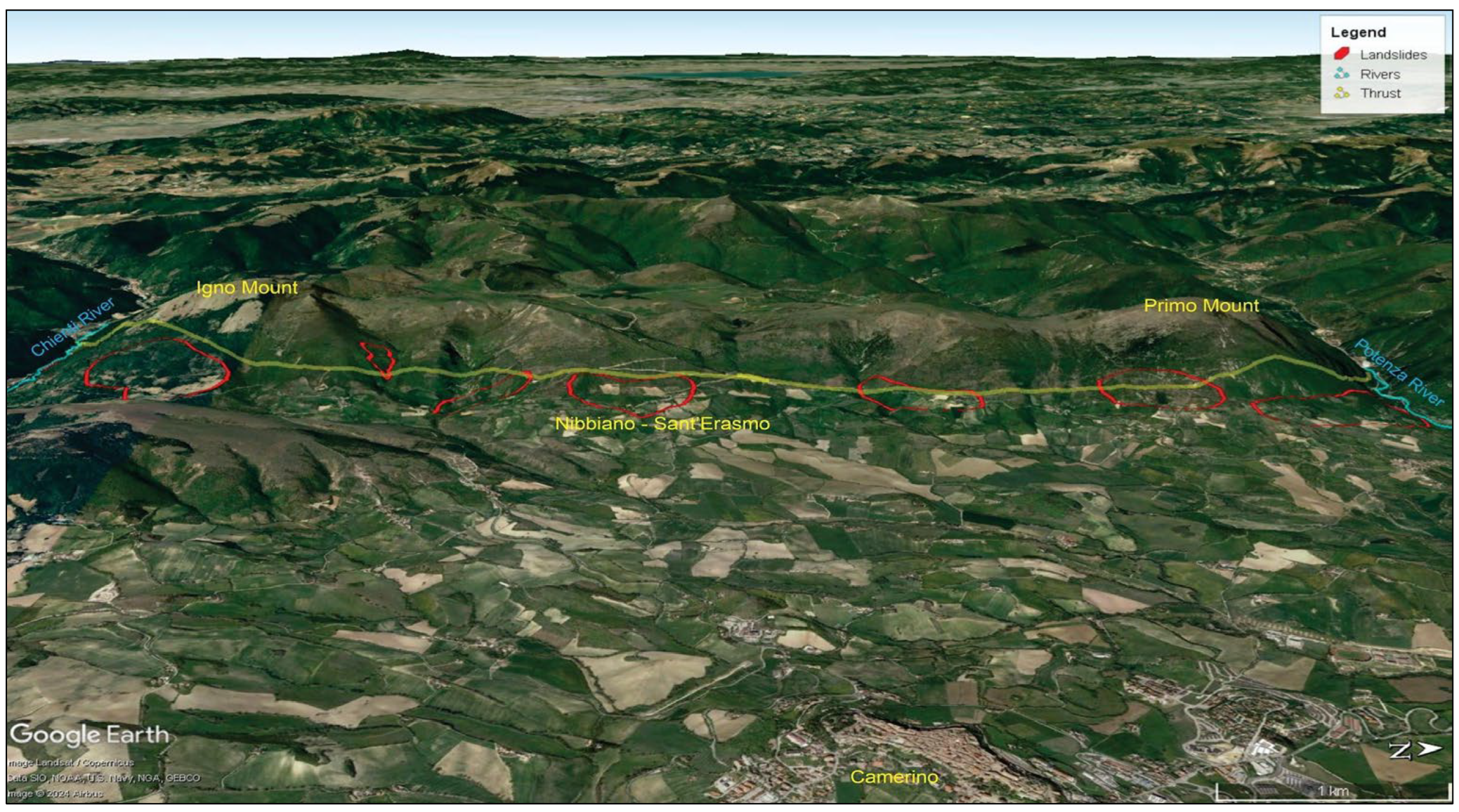
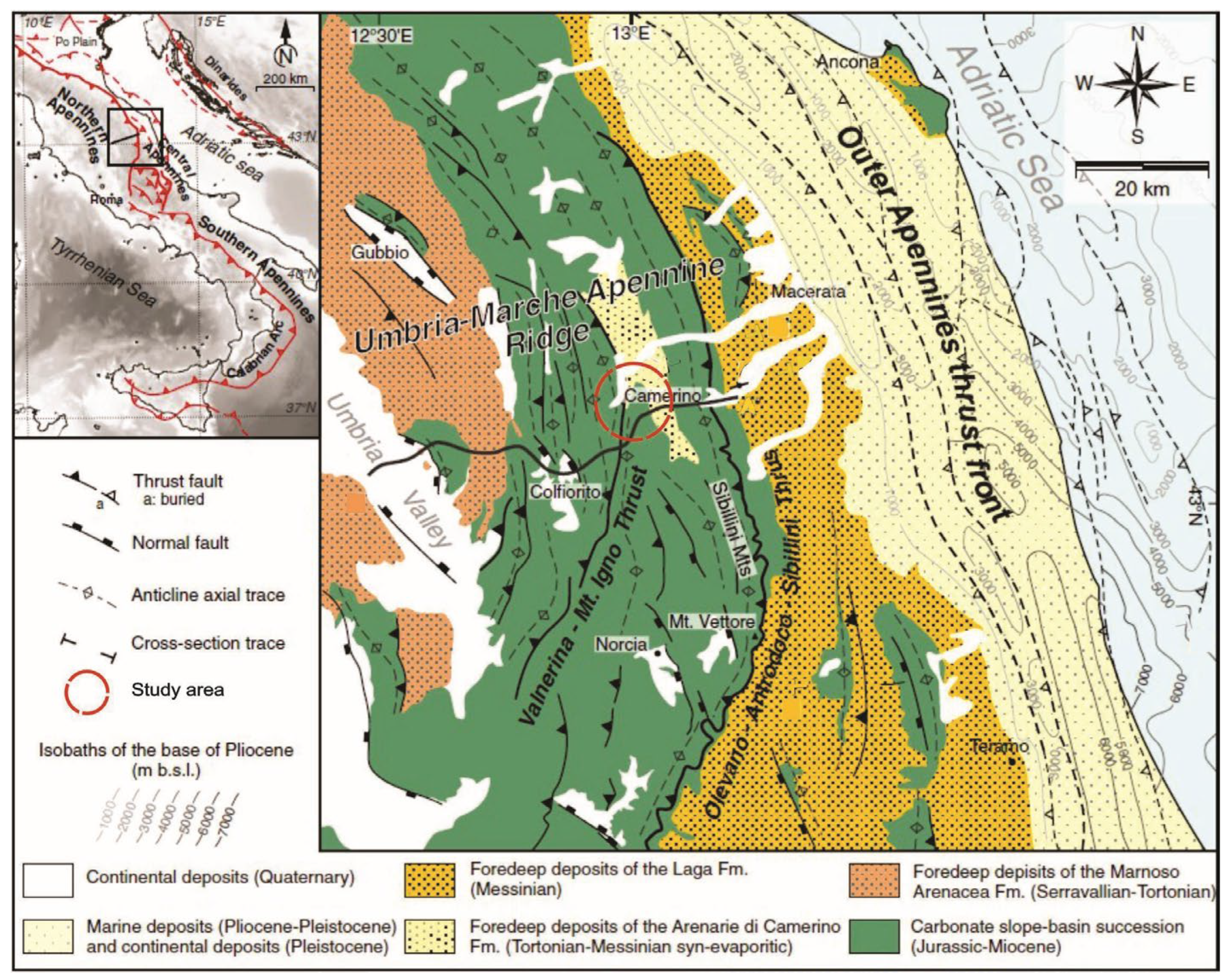
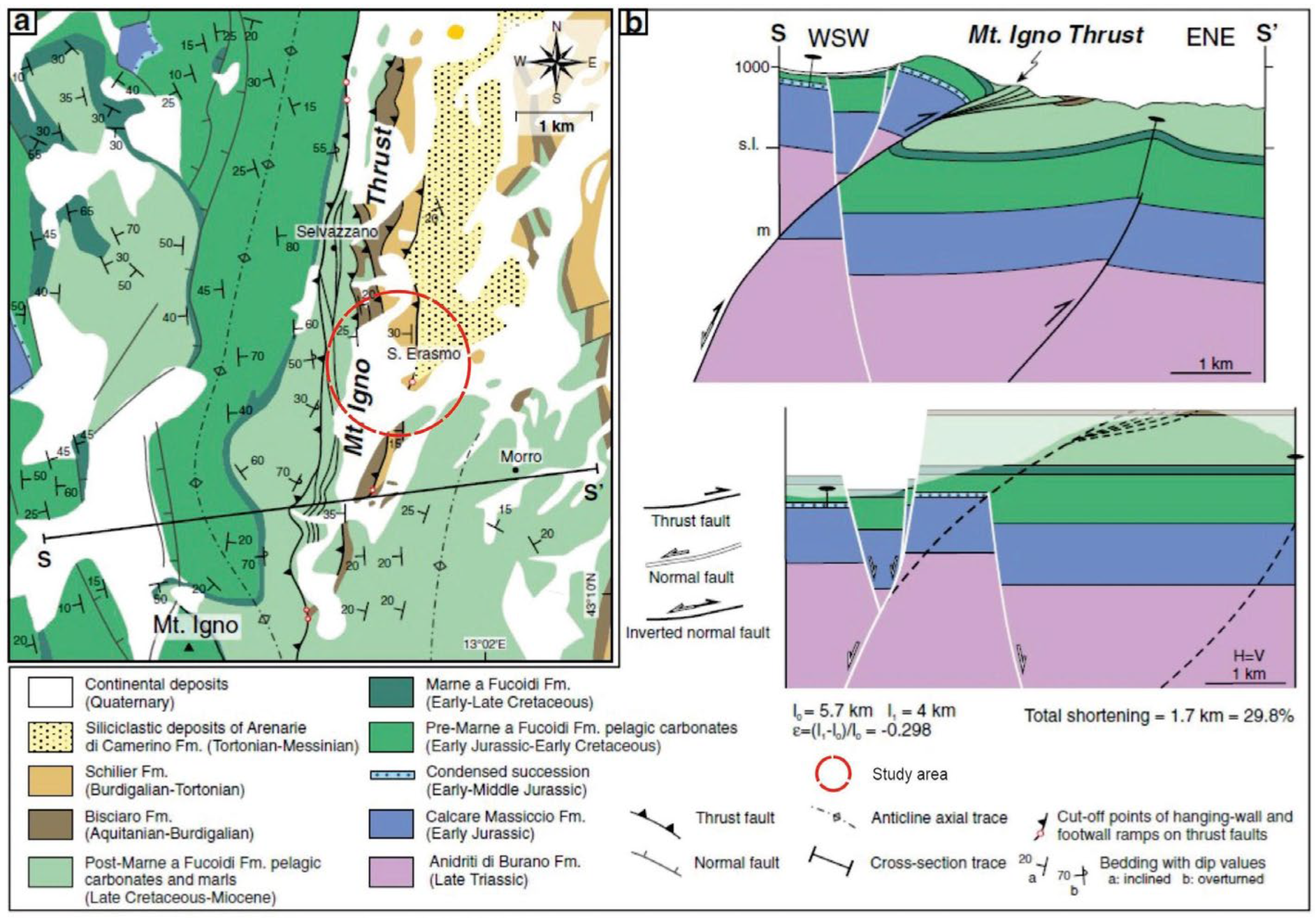
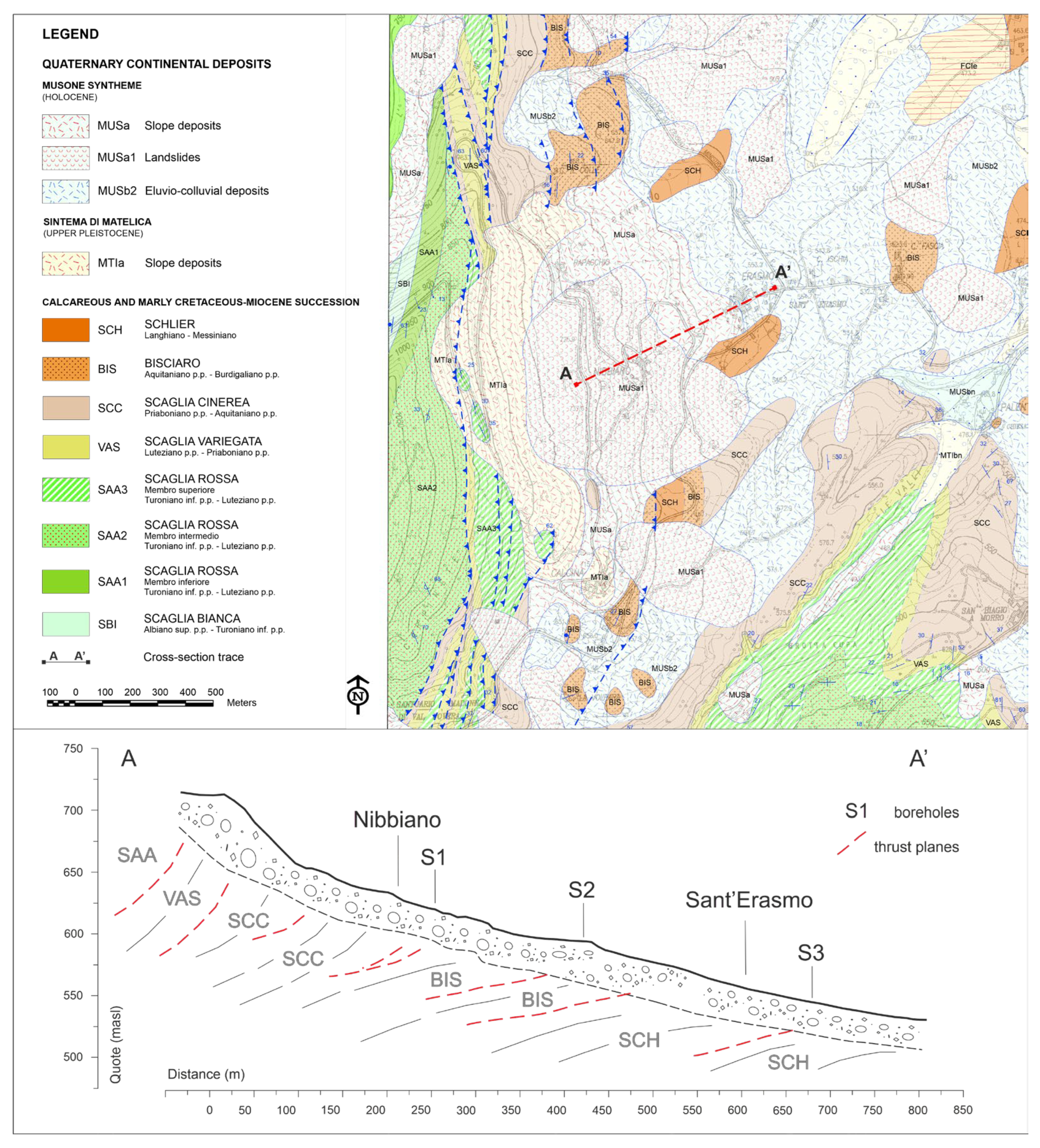
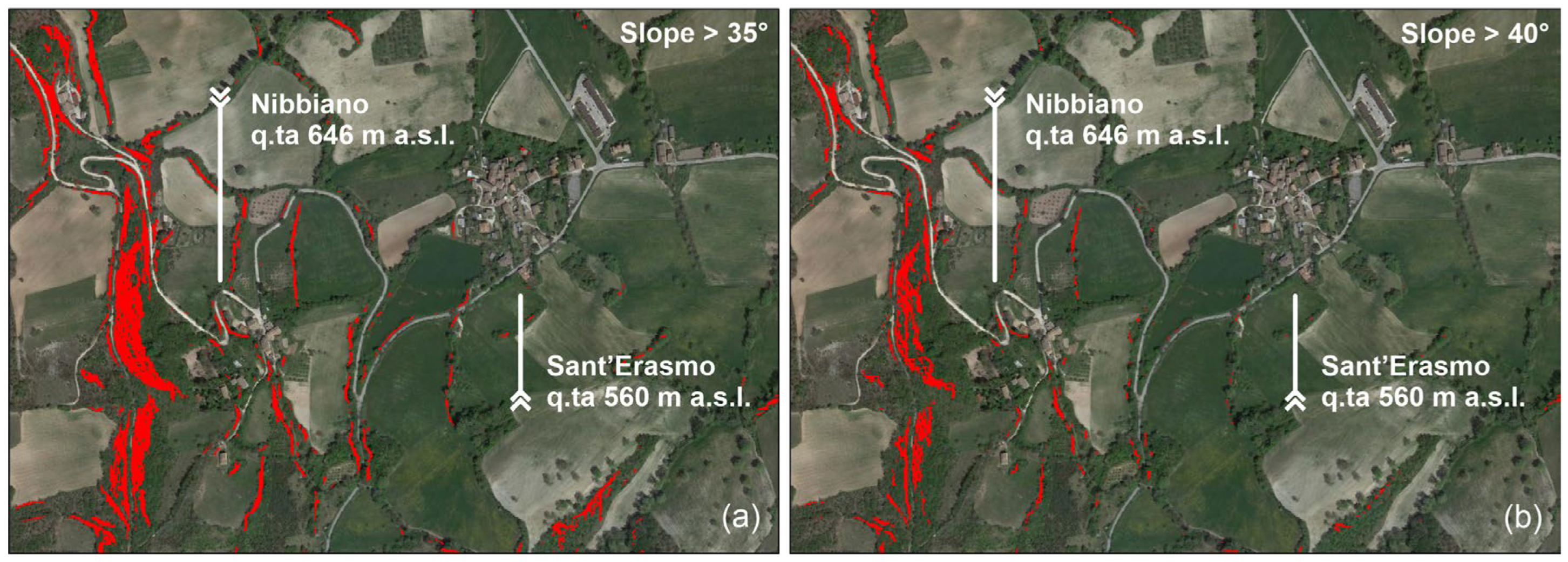
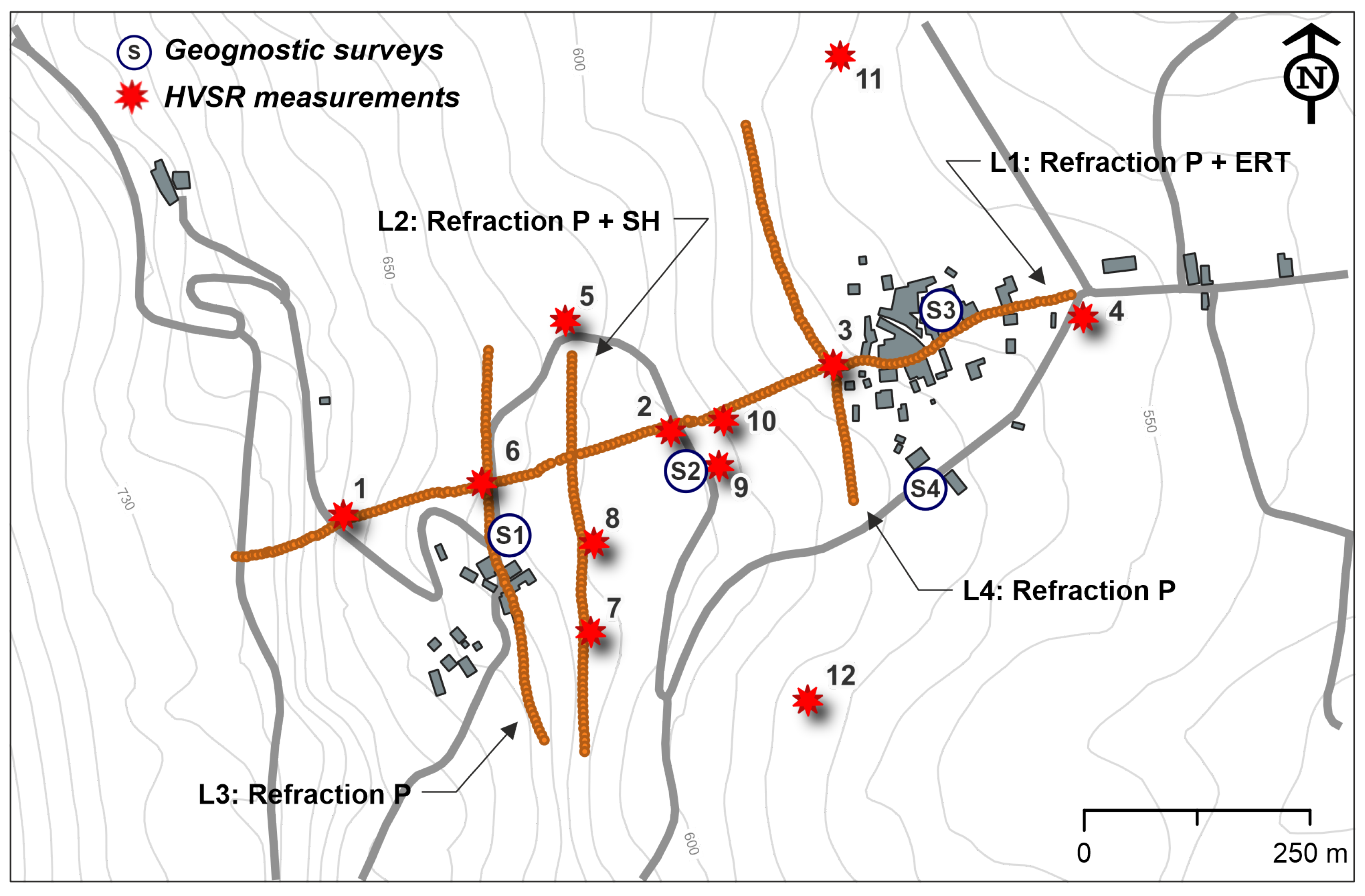
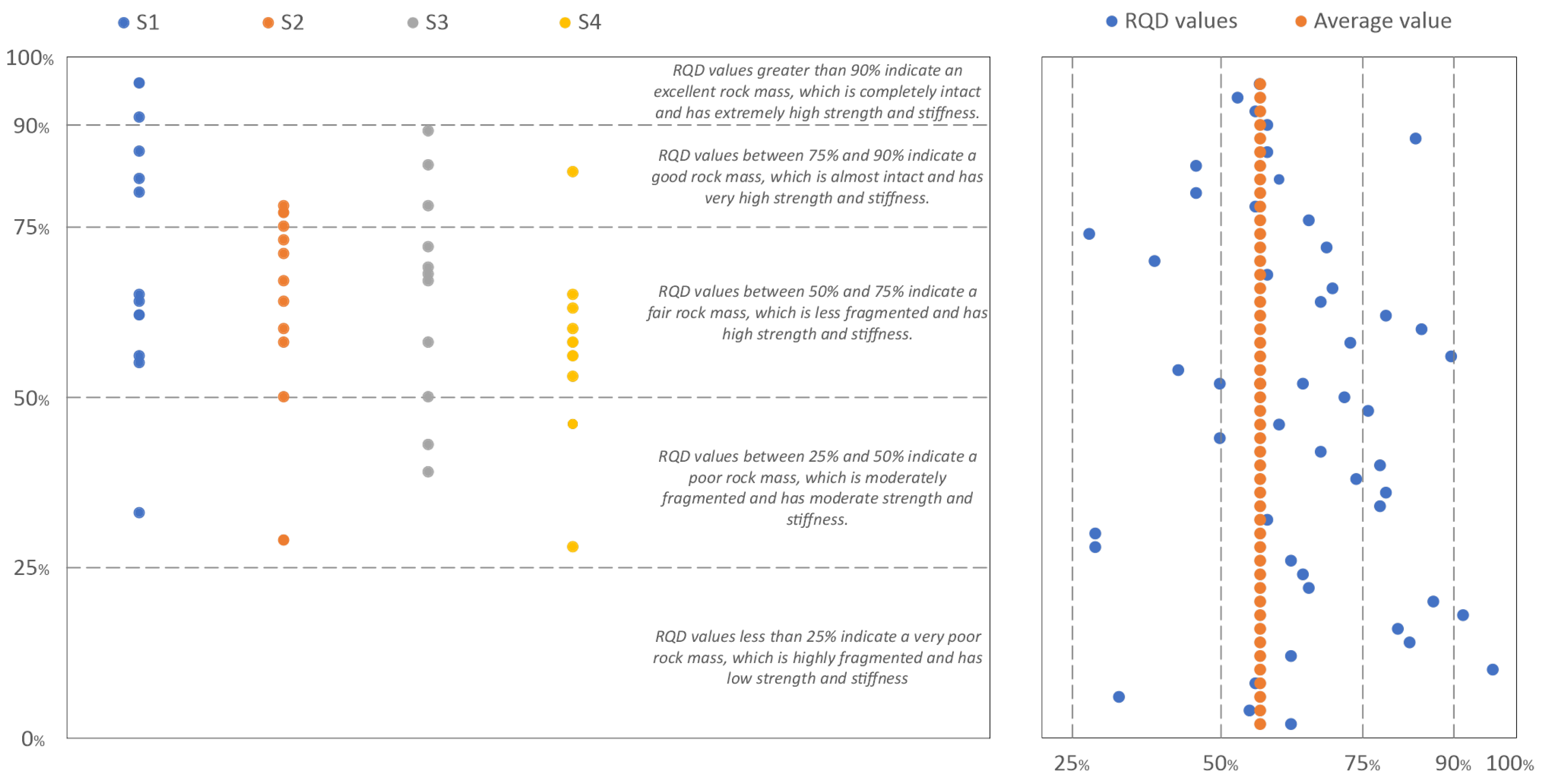
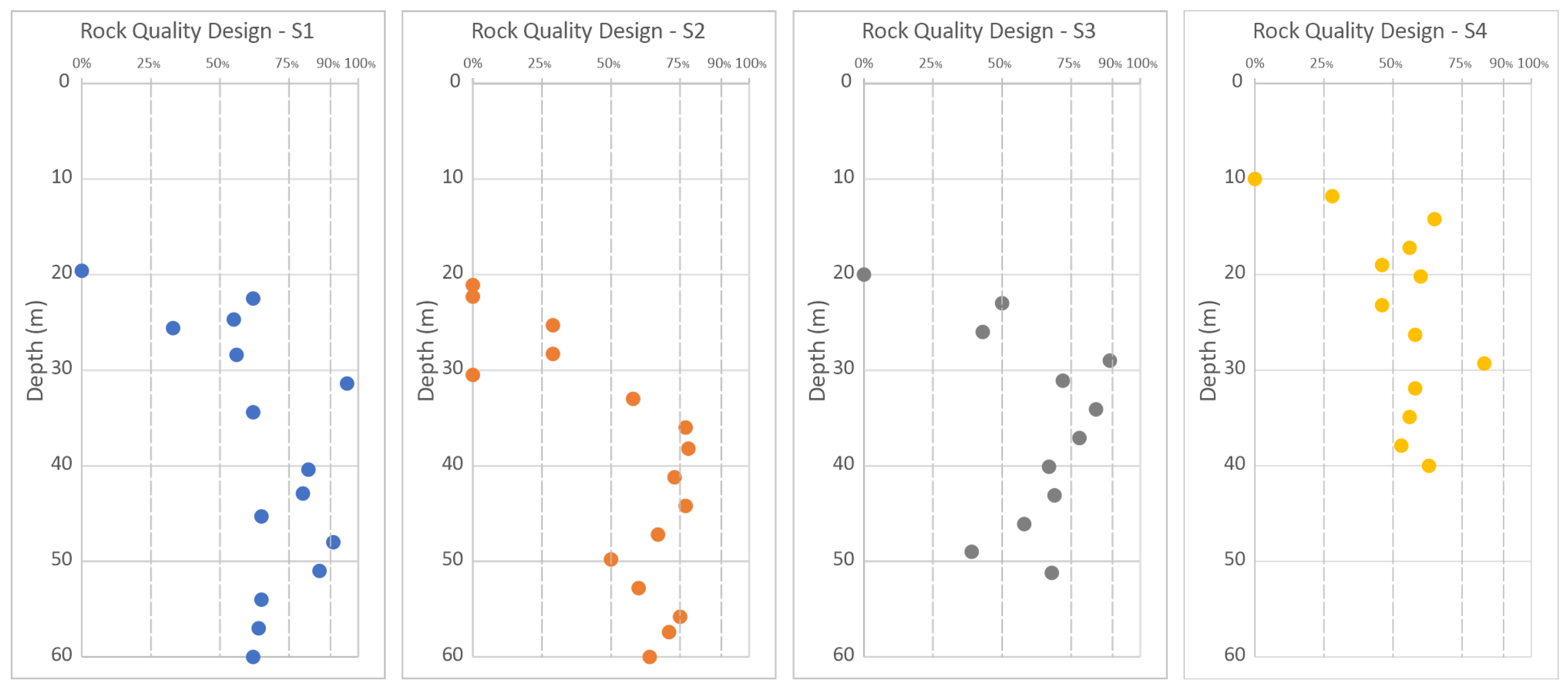
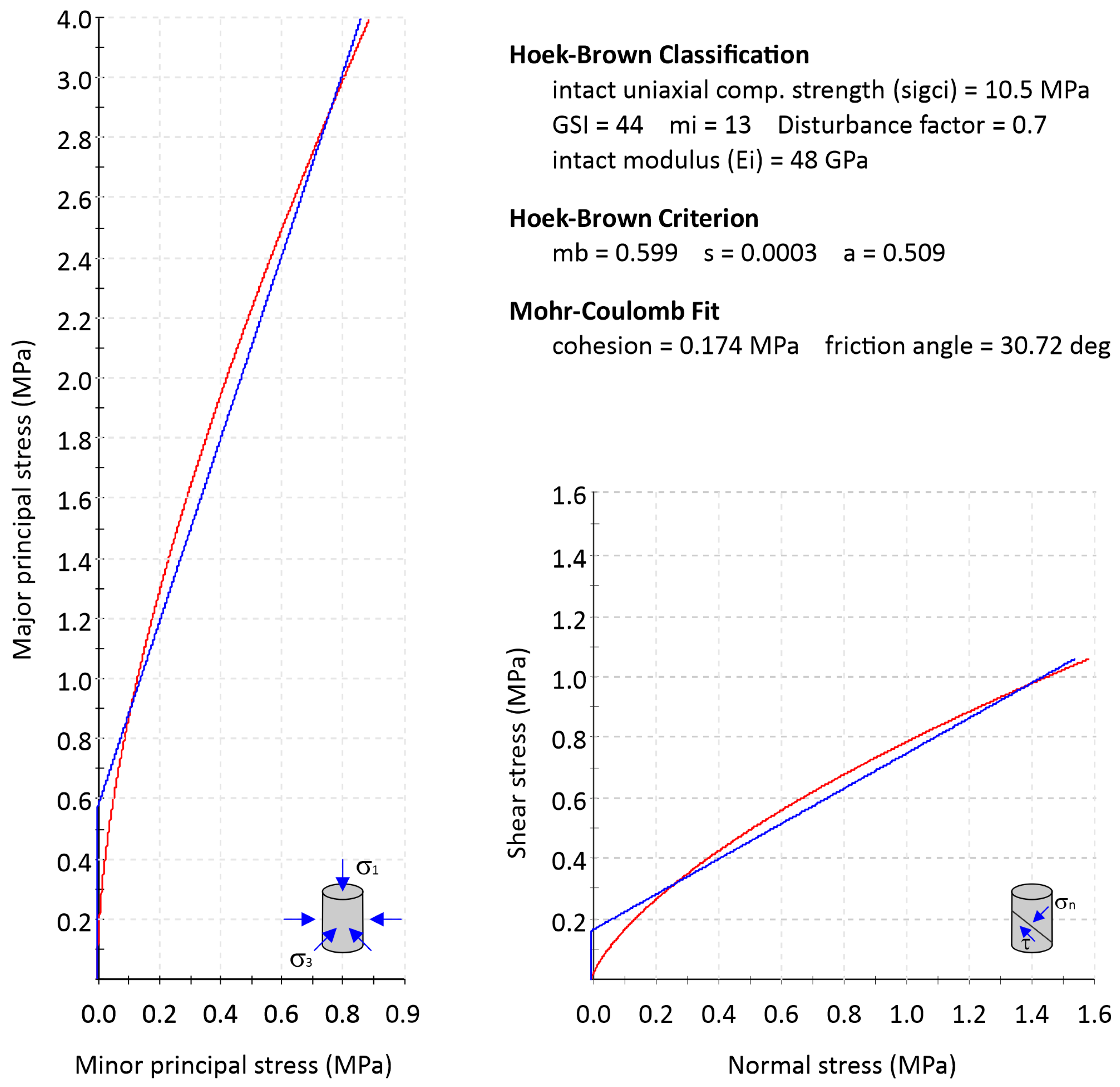
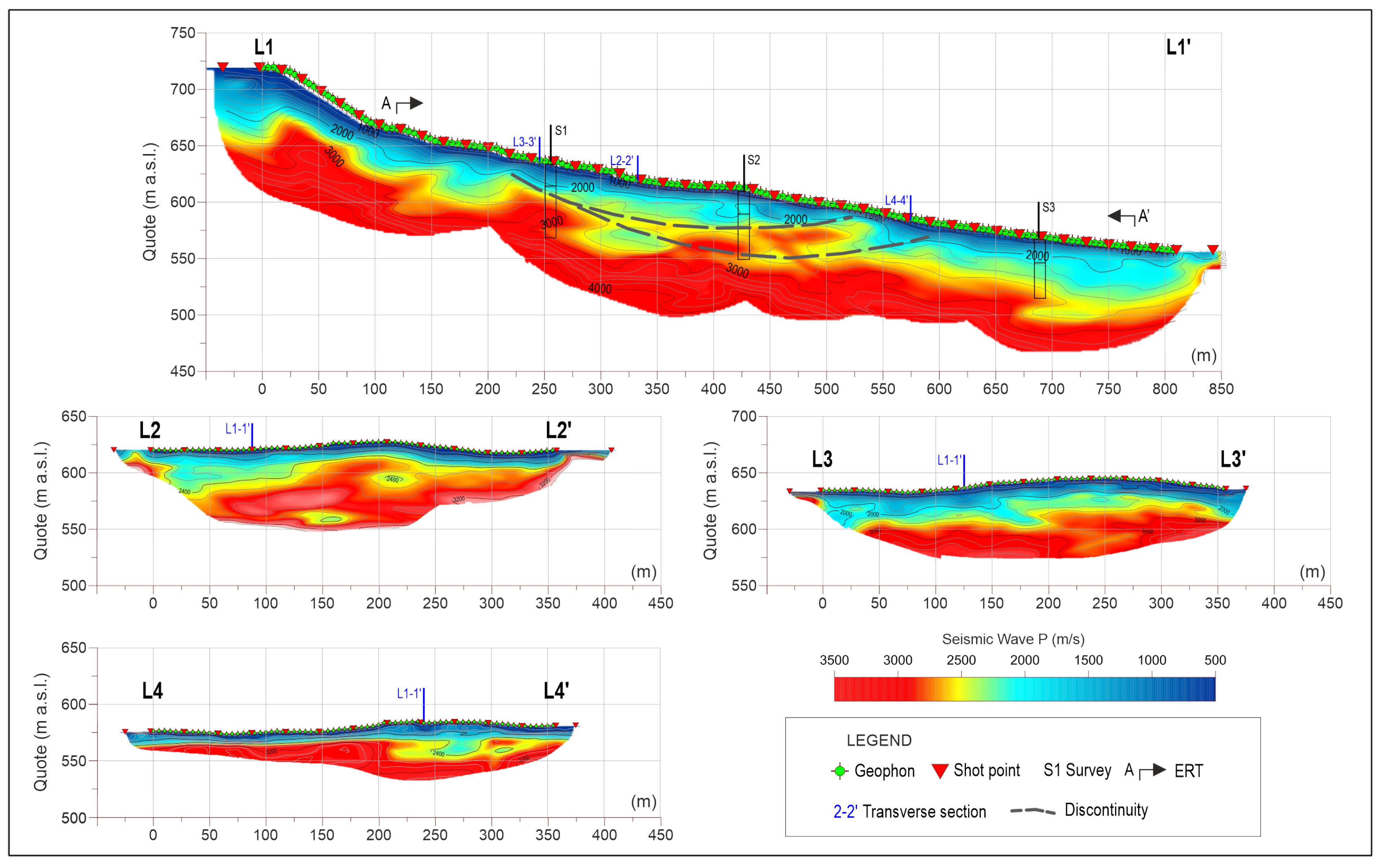
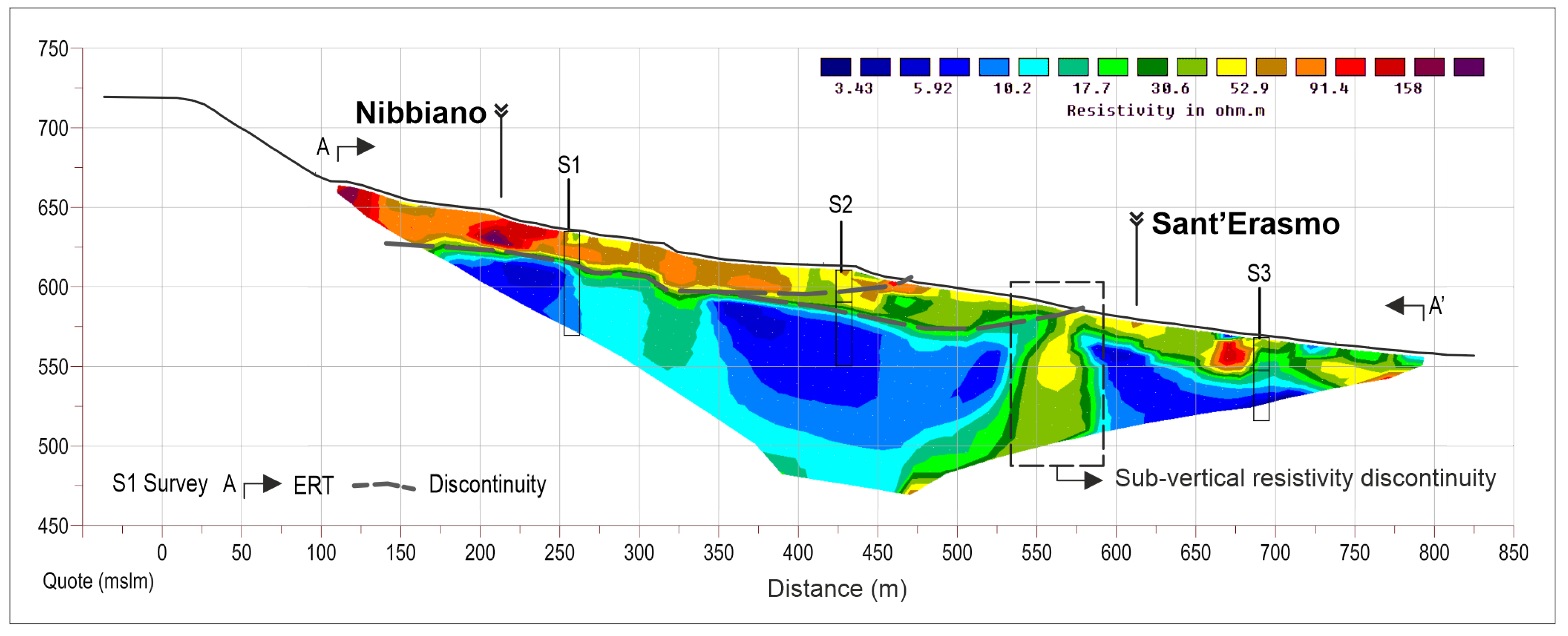
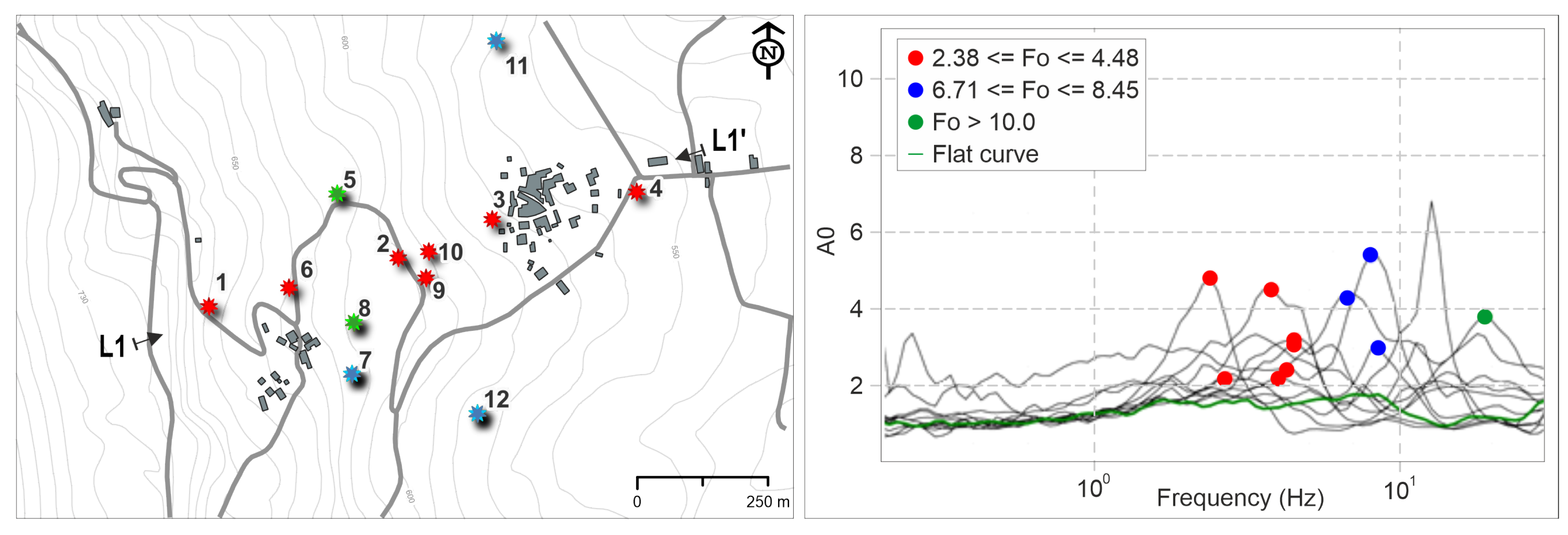
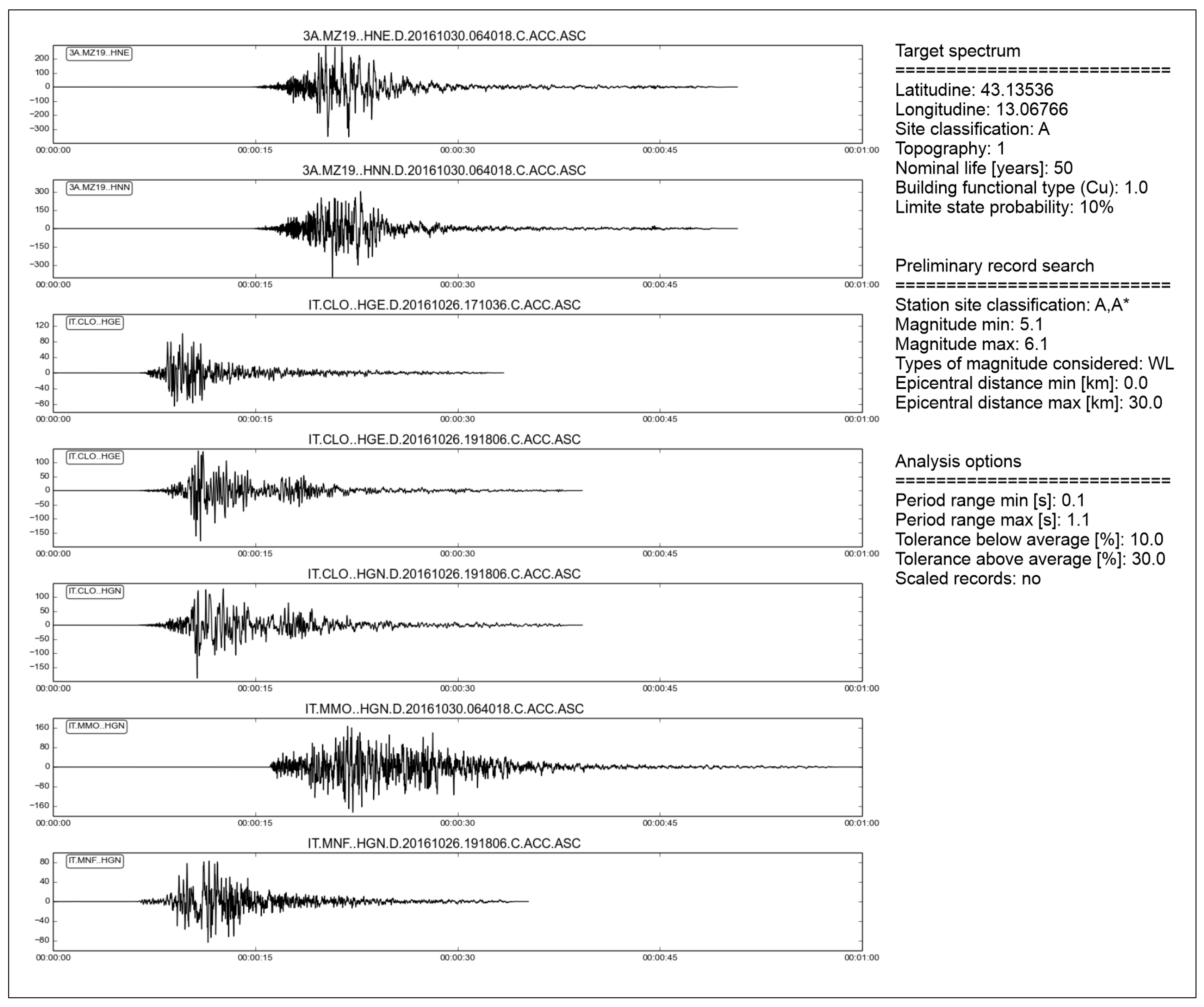
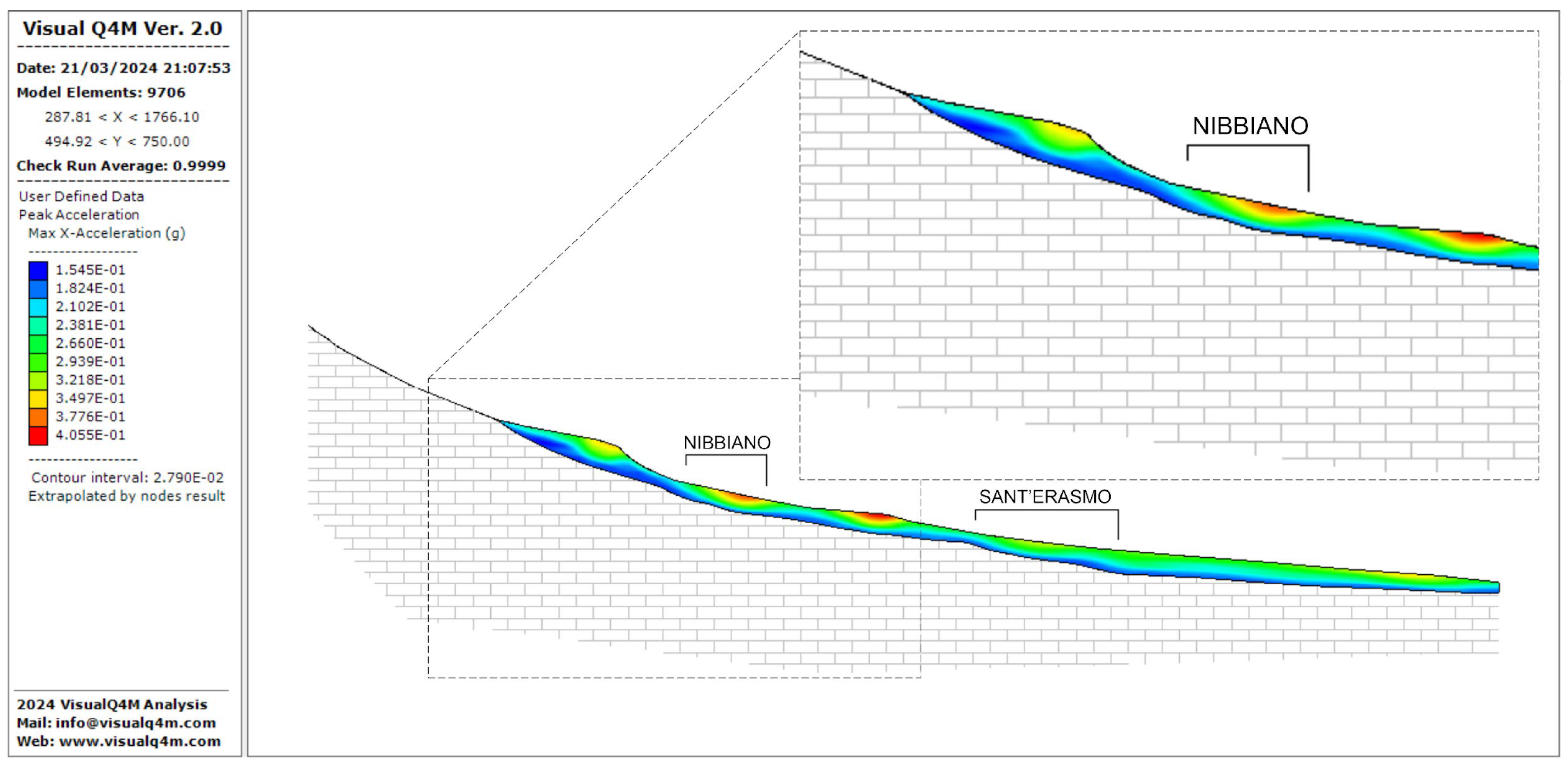
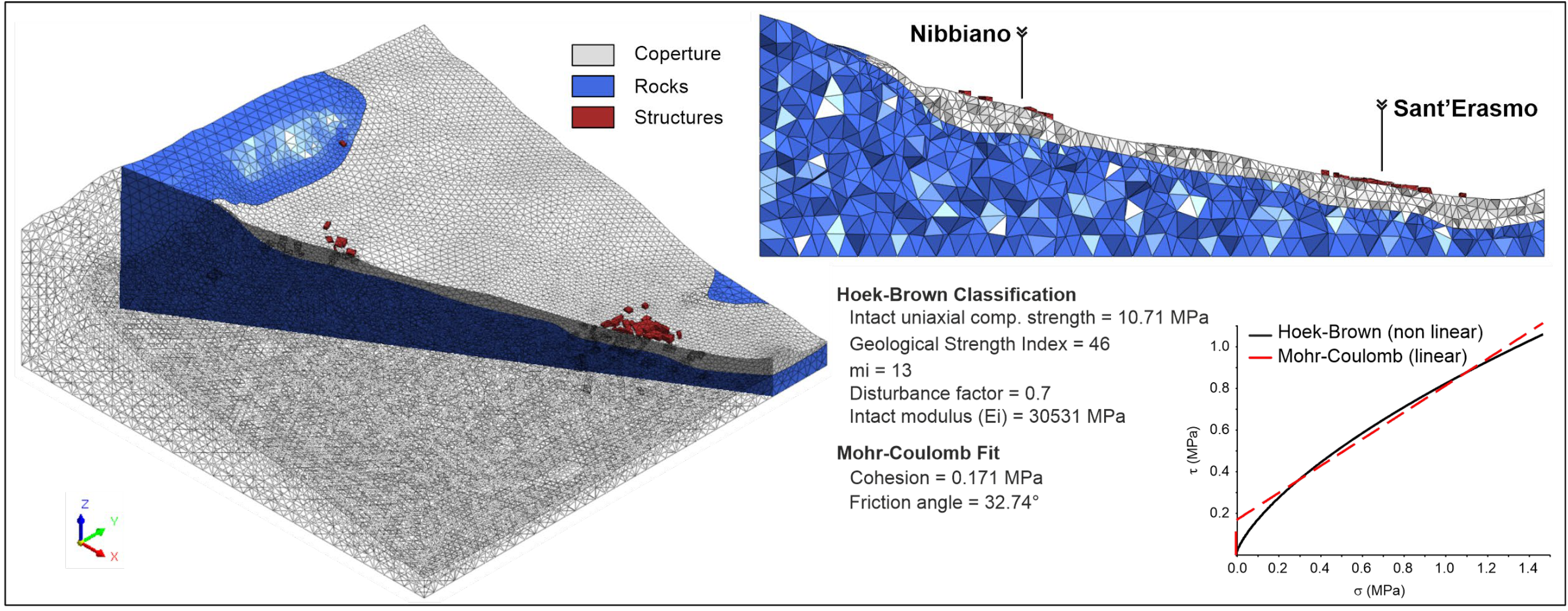
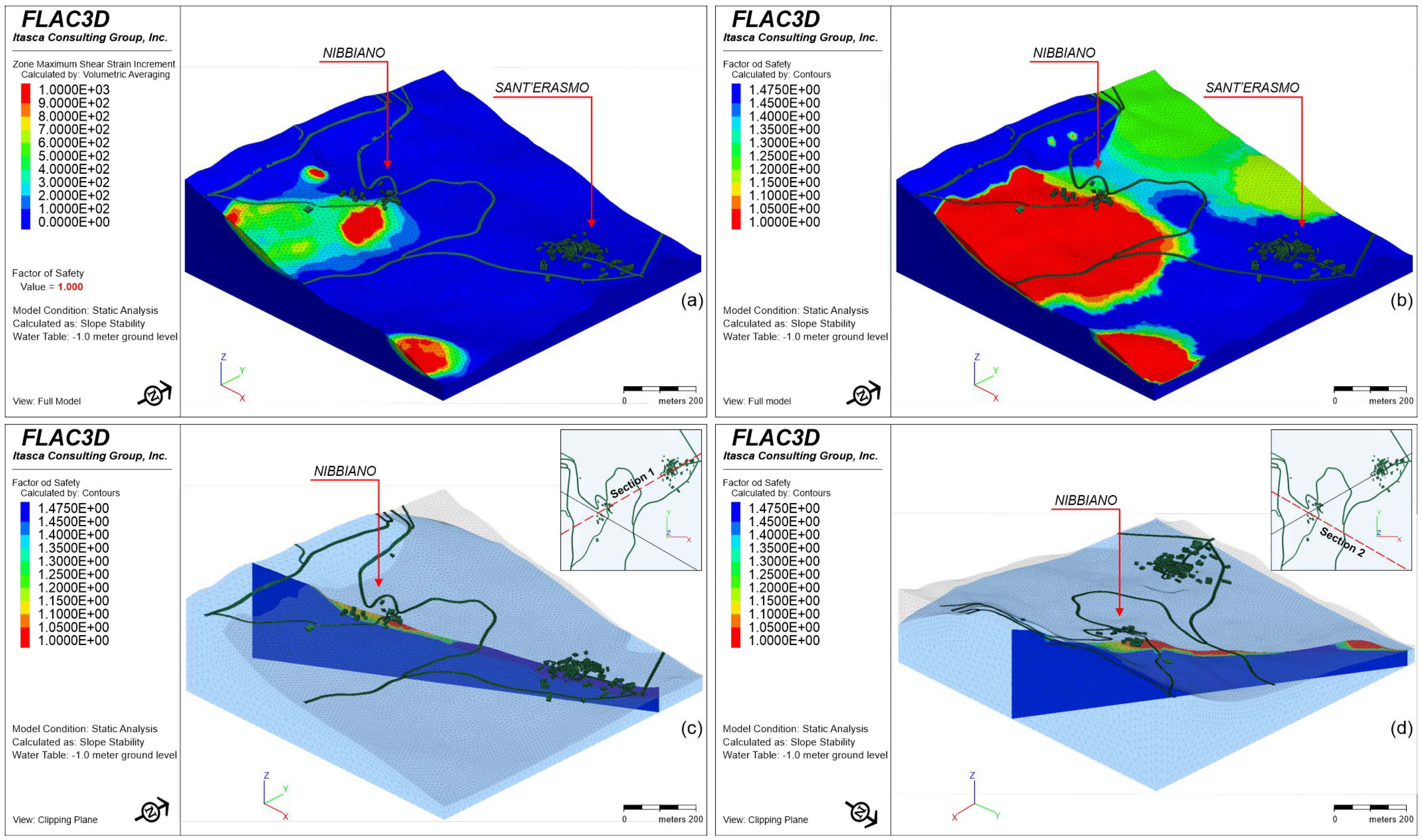

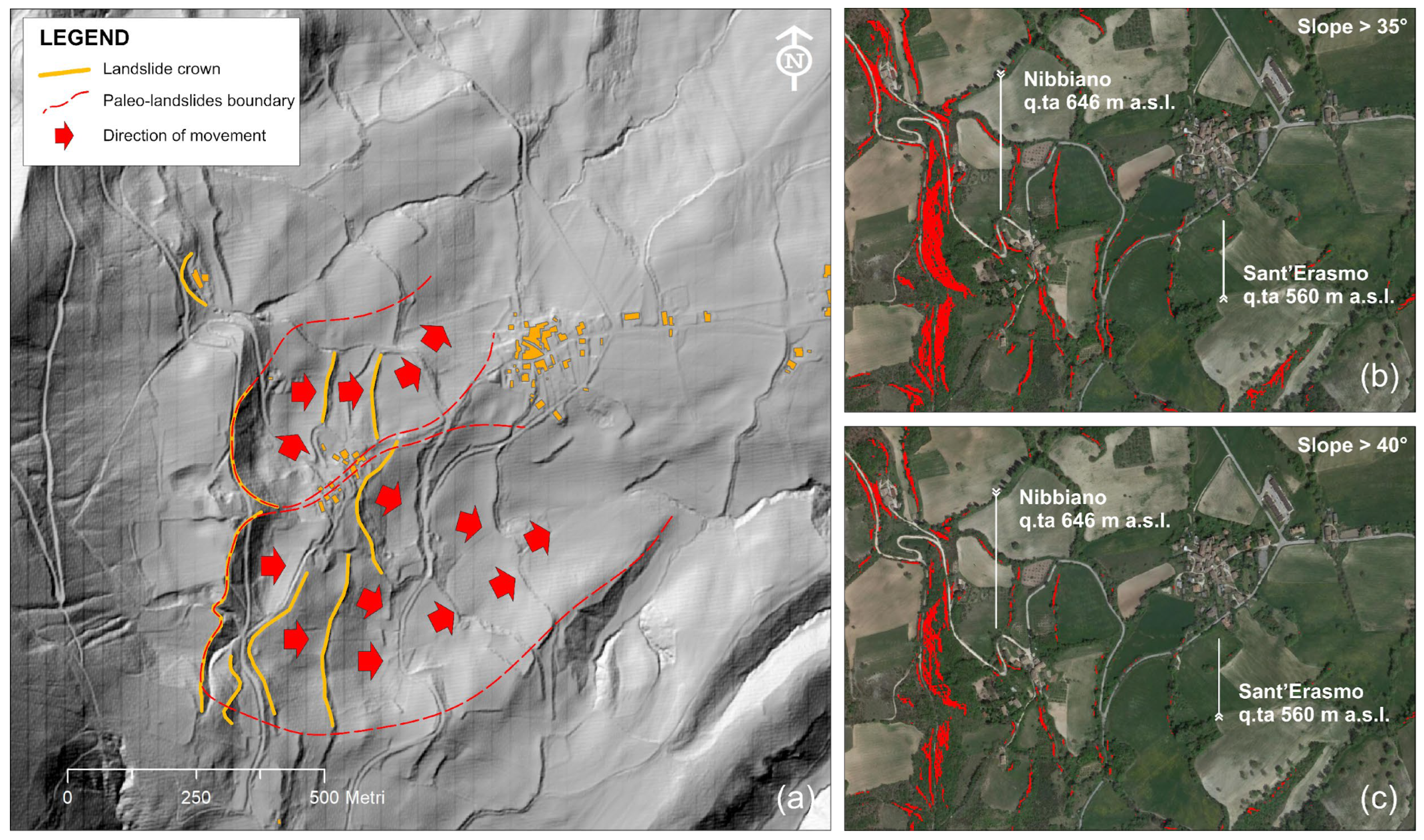
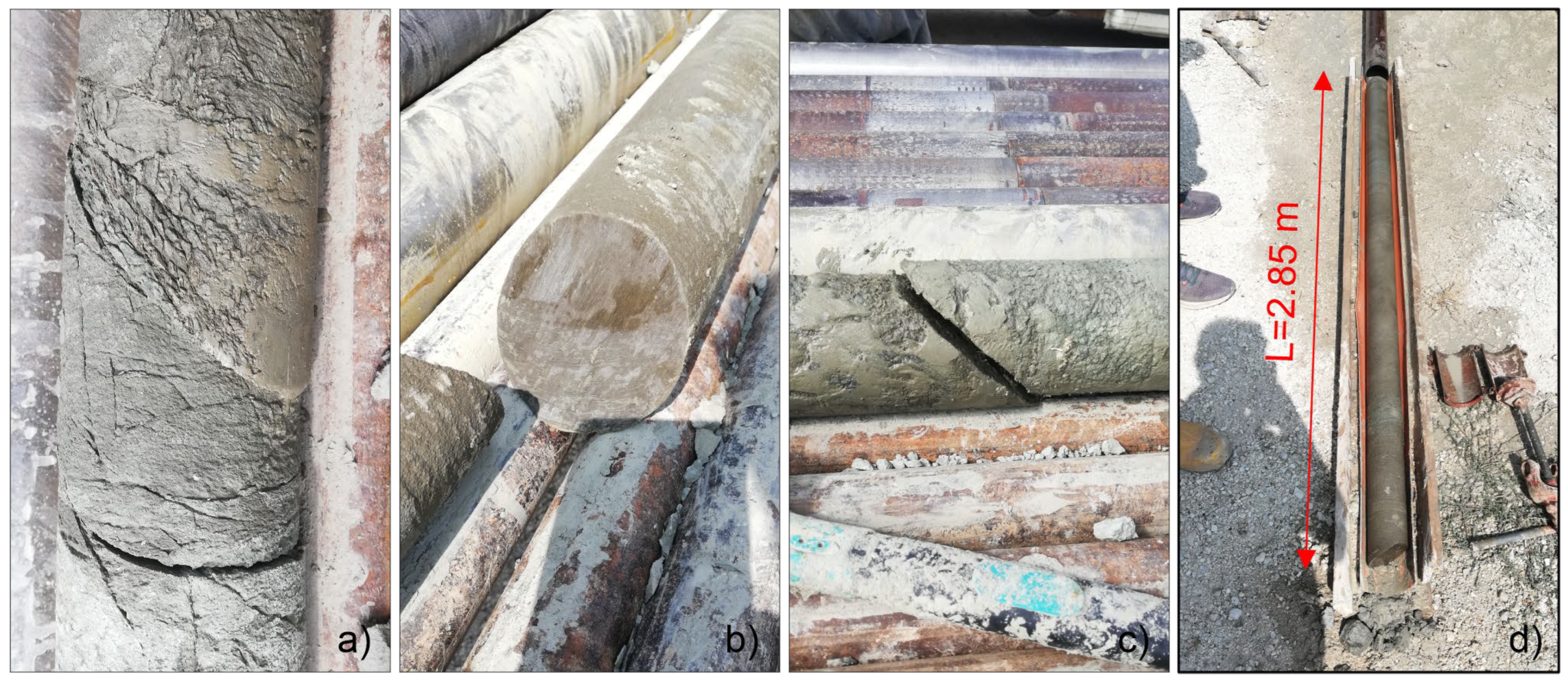
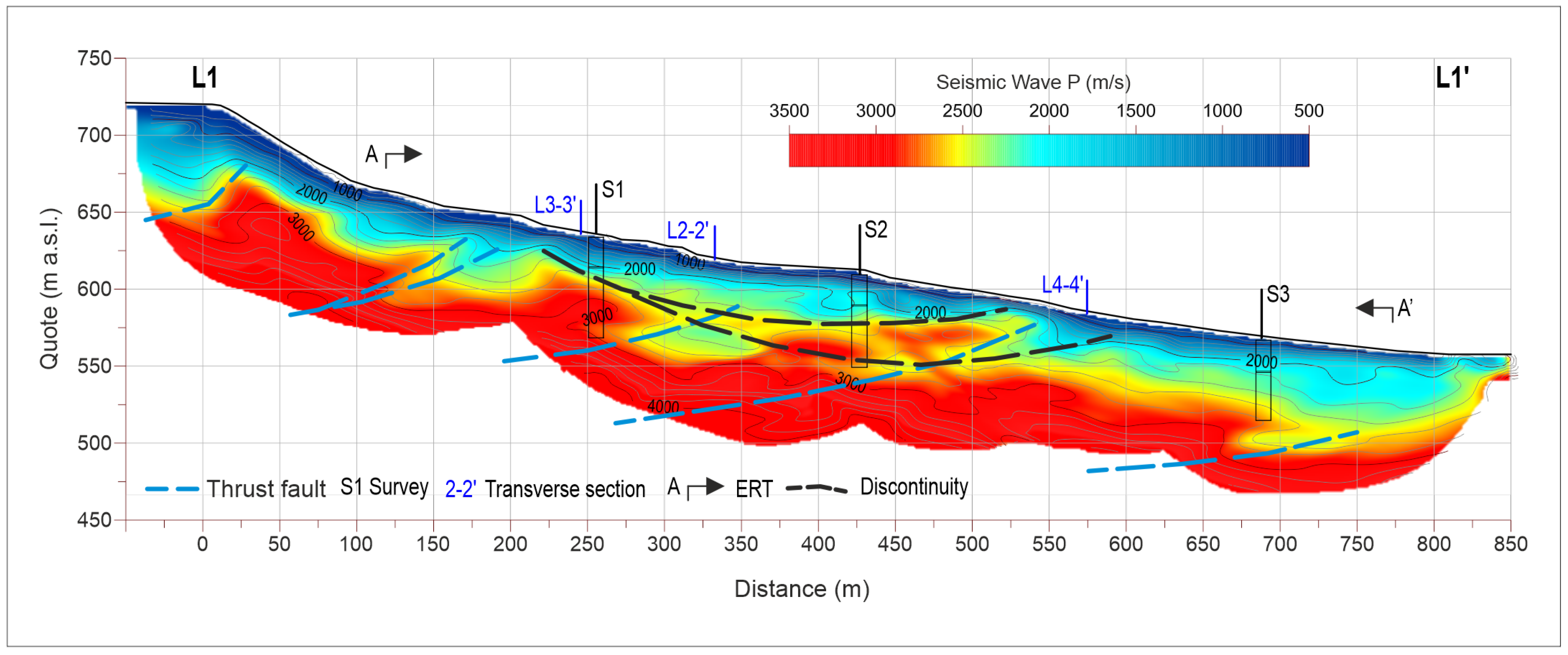
| Parameters | Records | Min | Max | Average | DevST | Characteristic |
|---|---|---|---|---|---|---|
| Friction (°) | 9 | 24.49 | 48.54 | 34.29 | ± 7.38992 | 29.43 |
| Young Mod. (MPa) | 9 | 3.60 | 24.30 | 10.33 | ±6.73515 | 5.91 |
| Parameters | Line 1 | Line 2 | Line 3 | Line 4 |
|---|---|---|---|---|
| Length (m) | 835 | 355 | 360 | 350 |
| Type | Wave P | Wave P-SH | Wave P | Wave P |
| Intergeophone distance (m) | 5.0 | 5.0 | 5.0 | 5.0 |
| Number of geophone | 168 | 72 | 72 | 72 |
| Parameters | Line 1 |
|---|---|
| Length (m) | 720 |
| Type | Array Wenner-Schlumberger |
| Interelectrode distance (m) | 10 |
| Number of electrodes | 72 |
| Layer | G/G0 and D Function |
|---|---|
| Cover layer | Rollins et al. (1998) |
| Bedrock | Elastic behaviour |
| Direction | X | Y |
|---|---|---|
| Seismic load | ||
Disclaimer/Publisher’s Note: The statements, opinions and data contained in all publications are solely those of the individual author(s) and contributor(s) and not of MDPI and/or the editor(s). MDPI and/or the editor(s) disclaim responsibility for any injury to people or property resulting from any ideas, methods, instructions or products referred to in the content. |
© 2024 by the authors. Licensee MDPI, Basel, Switzerland. This article is an open access article distributed under the terms and conditions of the Creative Commons Attribution (CC BY) license (http://creativecommons.org/licenses/by/4.0/).





